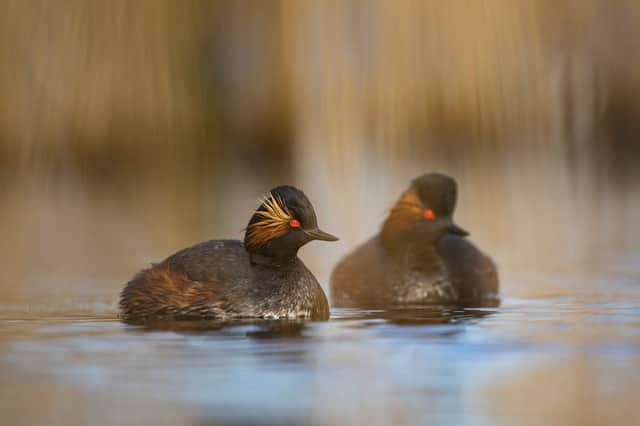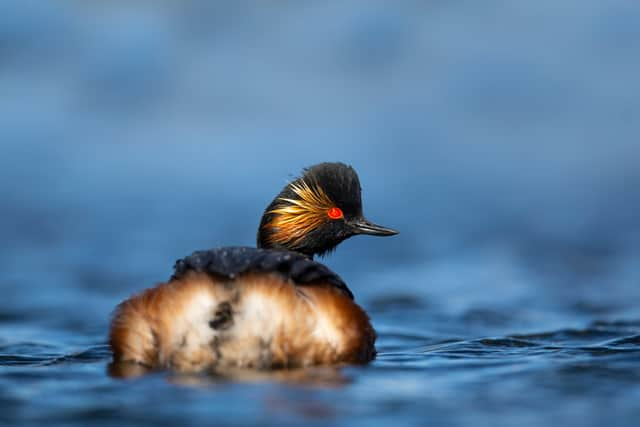Black-necked grebes: 'UK's rarest breeding birds' return to RSPB reserves after smash breeding season success


One of the UK's rarest breeding bird species, famous for its glamorous yellow ear feathers and extravagant dance, are making their way back to RSPB nature reserves after their best year on record.
After an intense conservation effort, the number of black-necked grebes has been on the rise across Royal Society for the Protection of Birds (RSPB) reserves, especially at RSPB St Aidan’s Nature Park, near Leeds. The reserve has just celebrated a record year for the species in 2023, and is now home to around 30% of the UK's breeding population of the rare and vulnerable species.
Advertisement
Hide AdAdvertisement
Hide AdAt the West Yorkshire nature reserve, expert conservationists and a team of volunteers have undertaken extensive habitat work, carefully managing water levels to create new areas of shallow water and dense reeds, to give the grebes an ideal spot to perform their dance, feed and nest. A record 18 breeding pairs were counted at RSPB St Aidan’s last year, and they managed to fledge the second highest number of chicks - 12 in total.


RSPB St Aidan's warden, John Ingham, said that the number of breeding pairs increasing offered hope that black-crested grebe numbers would continue to rise. "Black-necked grebes aren’t just one of the rarest breeding birds in the UK - they are also one of the most beautiful. Unmistakable with that piercing red eye, and golden ear tufts, at a distance they may be quite unassuming with their diminutive size, but up close they are simply stunning," he said.
Based on last year's successful breeding season and mild winter, he hoped good numbers of the birds would return to the reserve this spring. "But as with much of our wildlife, they face many challenges such as loss of wetland habitats, extreme weather events caused by climate change, declines in small fish and invertebrates they rely on for feeding, predation, and potentially, increased incidences of diseases such as avian influenza."
Mr Ingham added: "These threats make our work to maintain the perfect habitat conditions for wildlife like Black-necked grebes all the more important, especially if we are to enjoy the arrival of these beautiful birds at RSPB nature reserves for many years to come."
Advertisement
Hide AdAdvertisement
Hide AdA numerous bird throughout North America, Europe and Asia, the UK is right on the edge of the black-necked grebe’s breeding range, the conservation charity said, so the UK population is very small in number. Over the last five years, the population has averaged at around 54 pairs nationwide, meaning the species has an 'amber' classification on the UK's conservation concern list.
During winter, black-necked grebes hunker down on wetlands, large reservoirs and in coastal areas, but spring marks their annual return to nature reserves across the UK to breed. Usually found in reedbeds and other well-vegetated wetlands, these small glossy black birds have vivid tufts of golden feathers behind their bright red eye and, at this time of year, begin to perform a captivating ‘dance’.
This spectacular courtship display sees the male and female swimming in tandem, mirroring each other's movements, wagging heads and culminating in a ‘penguin dance’ as they rise up out of the water breast to breast. Once these efforts to woo a mate are successful, they go on to build floating nests amongst the reeds.
How can I see the black-necked grebes?
Despite the challenges Black-necked grebes are facing due to the nature and climate emergencies, the birds are likely to continue to arrive at RSPB nature reserves throughout March. Numbers are expected to peak in mid-April, before they disappear into the reeds to nest.
Advertisement
Hide AdAdvertisement
Hide AdVisitors have the best chance of catching a glimpse of them at the RSPB St Aidan's reserve during this time. However, the RSPB asks keen birders to keep to the plentiful paths to help these rare birds remain undisturbed, especially during the breeding season.
Comment Guidelines
National World encourages reader discussion on our stories. User feedback, insights and back-and-forth exchanges add a rich layer of context to reporting. Please review our Community Guidelines before commenting.
